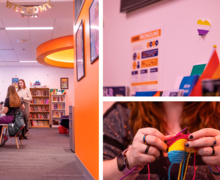As overdose deaths rise, local community looks to expand prevention initiatives
Flynn Ledoux | Contributing Illustrator
Onondaga County joined other health organizations in the state to provide prevention and mental health resources during the ongoing crisis.
Get the latest Syracuse news delivered right to your inbox.
Subscribe to our newsletter here.
Mariah Senecal-Reilly decided to work in the substance abuse prevention field after a shared experience she believes many have as the opioid epidemic continues to worsen across the country: a personal connection to opioid misuse or overdose.
Senecal-Reilly now serves as coordinator of Onondaga County Health Department’s Substance Use Initiative, where she oversees the department’s overdose prevention and harm reduction work. She said her personal experience relates to a family member of hers who has struggled with drug use over the past 15 years.
“When I propose initiatives and work to change things within the community, I just always think this could help people like my family member, or even my family member, so I think the personal experience really drives me,” she said.
Alongside Senecal-Reilly and the OCHD, various health organizations across the state — including New York State’s Office of Addiction Services and Support — are working to provide overdose prevention and harm reduction resources that will mitigate mental health issues and societal stigma.
In Onondaga County, 71 overdoses in the week of Nov. 4 marked the highest number of overdoses reported in a week for the county this year. The number of overdoses dropped slightly the week after to 56 overdoses, which is still approximately nine overdoses above the county’s weekly average in 2023.
Overdoses have also been on the rise in Onondaga County over the past several months. In the weeks between July 30 and Sept. 2, the county’s average weekly overdose count was 36.6, compared to 55.6 in the weeks between Oct. 8 and Nov. 11 — over a 50% increase.
Senegal-Reilly said Onondaga County has been “heavily impacted” by the opioid crisis, especially as the county features the largest urban center out of all the neighboring counties in central New York.
According to the county’s website, 2,115 overdoses have been reported so far in 2023. The county’s overdose statistics could be slightly skewed due to the county’s high population and location at a conjunction of several major highways, which Senegal-Reilly said can lead to increased movement of drugs throughout the area.
Dessa Bergan-Cico — coordinator of Syracuse University’s addiction studies program — noted that some zip codes within the county experience disproportionately more overdoses than others, namely 13202, which encompasses parts of downtown Syracuse to the east of Interstate 81. Bergan-Cico said that in many of these zip codes with higher overdose rates, there could be a tainted supply source distributed in the area.
“There’s some very clear patterns you can kind of see there which gives you the opportunity for prevention and intervention,” Bergan-Cico said.
To combat the rising overdose rates in Onondaga County, local health organizations have turned to a variety of overdose prevention resources.
Amongst these resources, one of the most effective and widely utilized is naloxone training and distribution, Senecal-Reilly said. Naloxone — more commonly known by one of its brand names, Narcan — blocks and reverses the effects of opioids in the nervous system and has been credited for saving the lives of 75% or more of people who receive the drug in time.
“Naloxone is the gold standard of overdose reversal,” Senecal-Reilly said. “We give out an incredible amount in many different ways so people can access it.”
To further expand access to naloxone, various health organizations also offer Narcan training online and in-person for organizations, community groups and individuals. OASAS and OCHD provide programs that allow members of the state and county to request delivery of free naloxone, along with fentanyl and xylazine test strips.
As a registered Opioid Overdose Prevention Program with the NYS Department of Health, the Syracuse City School District maintains a supply of Narcan in school health offices for emergency use. They also train health services staff members to recognize and deploy Narcan as needed, Nancy Bailey, director of health services at SCSD, wrote in an email statement to The Daily Orange.
SU’s Barnes Center at The Arch also has an NYSDH-registered OOPP that makes naloxone and other related harm reduction supplies available for the university community, the Barnes Center Health Promotion Team wrote in an email statement to The D.O. It also provides free Narcan training sessions. However, the university does not currently require Narcan to be physically present in campus buildings.
OCHD also supplies “NaloxBoxes,” stocked by the Prevention Network, throughout the county where people can take naloxone doses as needed. ACR Health also hosts a Syringe Exchange Program to provide free sterile syringes and other harm-reduction supplies.
Evan Frost, the assistant director of communications and public information at OASAS, said overdose prevention resources such as naloxone and testing strips are important to addressing rising overdoses across the state. More than 6,300 New Yorkers died last year of an overdose, which is approximately one every 90 minutes, he wrote in an email to The D.O.
“The current overdose epidemic is the worst on record, and we need to do all that we can to keep people alive,” Frost wrote.

Sierra Zaccagnino | Digital Design Editor
Bergan-Cico said medications that prevent withdrawal, such as methadone or buprenorphine, are another important form of overdose and addiction prevention as the opioid epidemic continues.
“If people have real tissue dependency, (medication) can help so that they are not struggling with the physical symptoms of withdrawal which can make it really difficult to change behavior when people are preoccupied with the physical symptoms,” Bergan-Cico said.
She added that there aren’t currently enough resources dedicated to addressing mental health’s role in addiction too.
“If it’s stress, depression, trauma, other things that might be a trigger or foster craving, it’s really working on addressing those things and it’s not a one-off type of thing,” Bergan-Cico said. “You’re really looking at changing neural networks, and ways of thinking and ways of behaving and it takes weeks, if not months to start to do that.”
Senecal-Reilly agreed that mental health resources, in addition to widespread access to Narcan, play a key role in normalizing addiction treatment and providing support for people struggling and their families.
“Not only the person who’s using, but the families as well are able to feel like they don’t have to conceal it in, they’re able to feel a bit more support,” she said.
As health organizations work to implement effective overdose prevention measures, the stigma surrounding drug addiction has proved a challenge, Senecal-Reilly and Frost said.
Despite observing improvement in recent years, stigma is still a barrier for people struggling with addiction and often convinces individuals to conceal drug-related issues instead of seeking help, Senecal-Reilly said.
Frost echoed a similar sentiment regarding OASAS’ work to provide resources to New York’s population. He cited stigma against people affected by addiction and the treatment services available as the No. 1 challenge the agency faces, saying opposition against addiction treatment remains in many communities, despite it being proven to save lives.
“It is vitally important that we reduce the stigma regarding addiction treatment, and help people find services when they are in need by meeting them wherever they are in their recovery,” Frost wrote.
Another challenge Bergan-Cico noted was the lack of people in the field of addiction studies and harm reduction, and the lack of education and training in the complexities of addiction among health professionals.
Despite these challenges, Senecal-Reilly said her work provides the ability for those with personal connections to opioid misuse to help somebody they care about through overdose prevention and harm reduction.
“You would be hard-pressed to find somebody who doesn’t have a connection to an overdose or a family member who uses drugs and having resources available for the community at large gives them the ability to feel empowered to help somebody,” she said.
To access free Narcan, fentanyl test strips and xylazine test strips from the Onondaga County Health Department, call (315) 418-5365. For addiction and mental health support, call SAMHSA’s National Helpline at 1-800-662-4357.
Published on November 16, 2023 at 12:01 am
Contact Samantha: saolande@syr.edu






